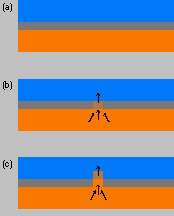
In order for convection to occur, a small plume of hot fluid which begins to rise toward the top of the cell must grow in strength, rather than fizzle out. (In mathematical terminology, the mode corresponding to the flow must have an eigenvalue greater than unity.) Physically, this corresponds to the competition of three processes. The amplification mechanism is illustrated in the picture below.
Suppose that the bottom of the fluid layer has been gradually heated from below, and the temperature gradient has had time to develop. This is represented in panel (a), where orange represents hot water, blue represents cooled water, and grey represents water at the mean temperature. The temperature actually spans a continuous spectrum, but for simplicity, the picture represents the situation with descrete colors. (If you have a greyscale system, then red will probably be a lighter shade of grey than blue.) Although the density gradient is unstable, the fluid does not experience any buoyancy force, because each particle of fluid is at the same temperature as the fluid on all sides, and therefore has the same density. (There are temperature differences with fluid above and below, but this does not produce a buouancy force.)

In panel (b), a fluctuation has occured, and a small parcel of fluid at the center of fluid is hotter than the neighboring fluid. The pressure difference between the top and the bottom of this parcel of fluid exceeds it's weight, so it experiences a buoyancy force, and it begins to rise. Fluid comes up from underneath to fill the void left by the rising fluid. Panel (c) illustrates the fact that the temperature fluctuation is amplified, because the fluid which comes up from under the rising parcel of fluid is from the bottom of the cell, and is hotter than the fluid above. By drawing up fluid from the hot region of the cell, the original temperature fluctuation is amplified, and the plume of rising fluid becomes stronger with time. The larger the temperature difference, the more quickly the temperature fluctuation is amplified.
There are two processes which oppose this amplification. First, viscous damping in the fluid directly opposes the fluid flow. In addition, thermal diffusion will suppress the temperature fluctuation by causing the rising plume of hot fluid to equilibriate with surrounding fluid, destroying the buoyant force. Convection occurs if the amplifying effect exceeds the disippative effect of thermal diffusion and buoyancy. This competition of forces is parameterized by the Rayleigh number, which is the temperature difference, but appropriately normalized to take into account the geometry of the convection cell and the physical properties of the fluid. If the Rayleigh number is greater than 1708, then convection occurs. If it is below this value, there is no convective flow. Throughout this pave, we will use the reduced Rayleigh number, which is normalized to the onset value of 1708. Using this convention, convection occurs for Rayleigh number greater than 1.
If the temperature difference is very large, (Rayleigh number>>1) then the fluid rises very quickly, and a turbulent flow may be created. If the temperature difference is not far above the onset, an organized flow resembling overturning cylinders is formed. It is the patterns created by these convection "rolls" that we study.

Back to the convection page